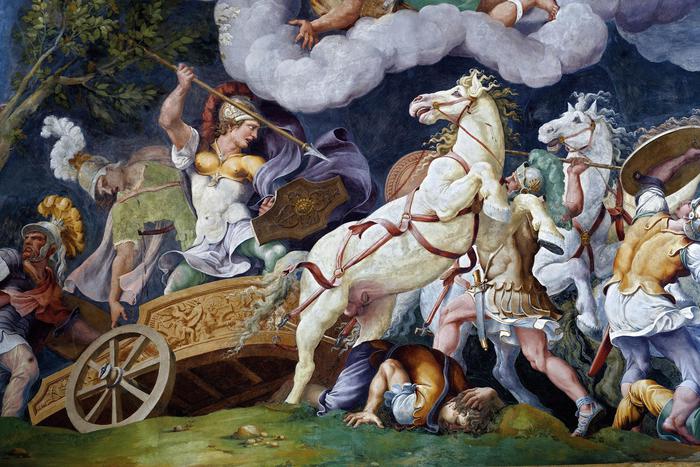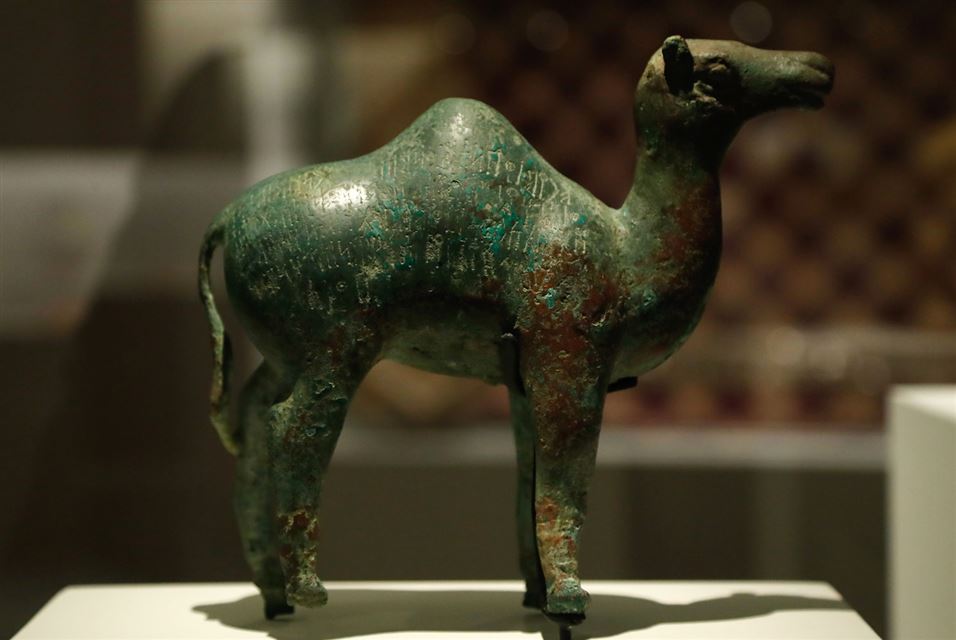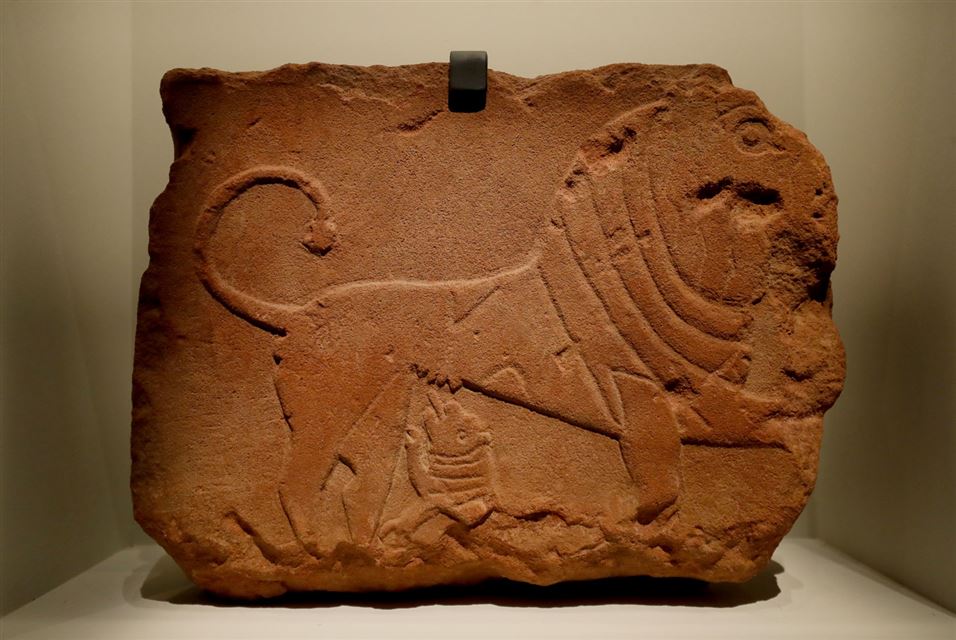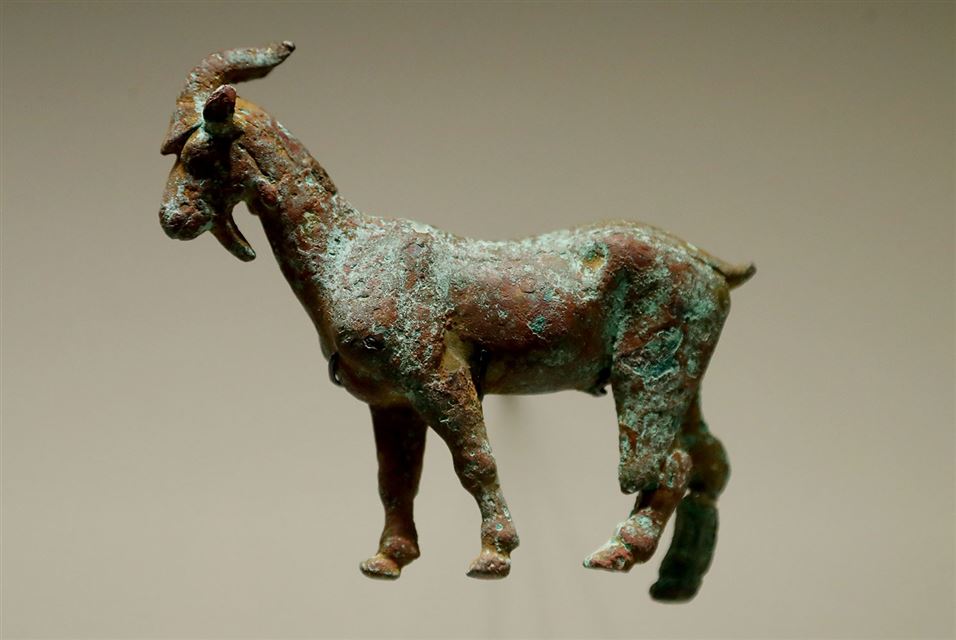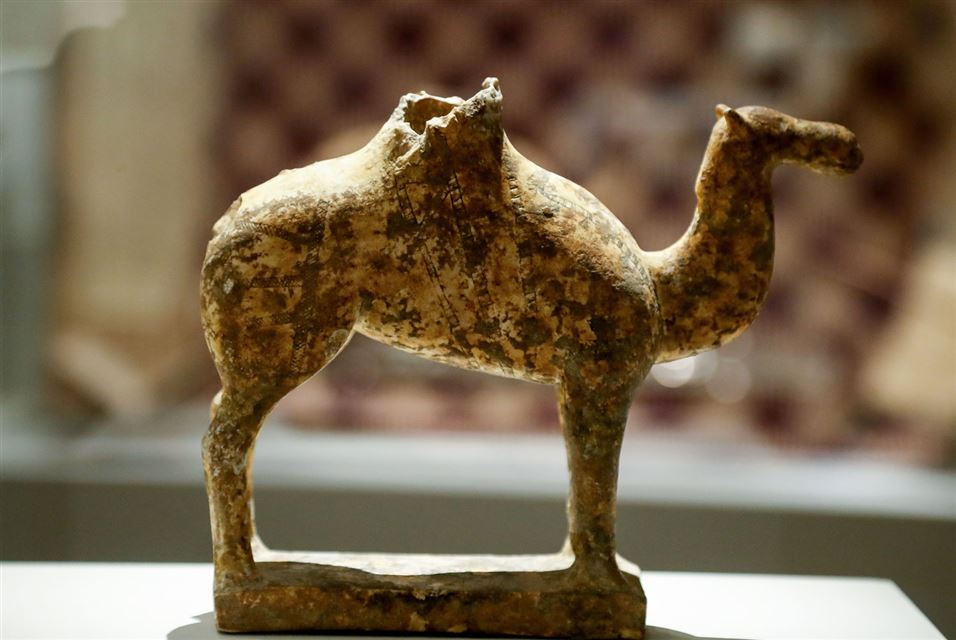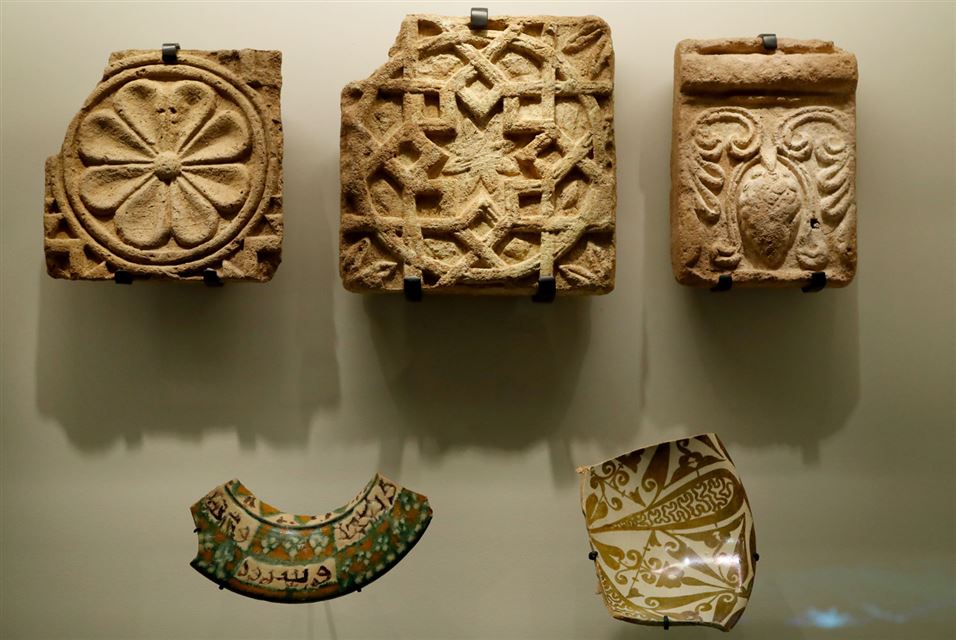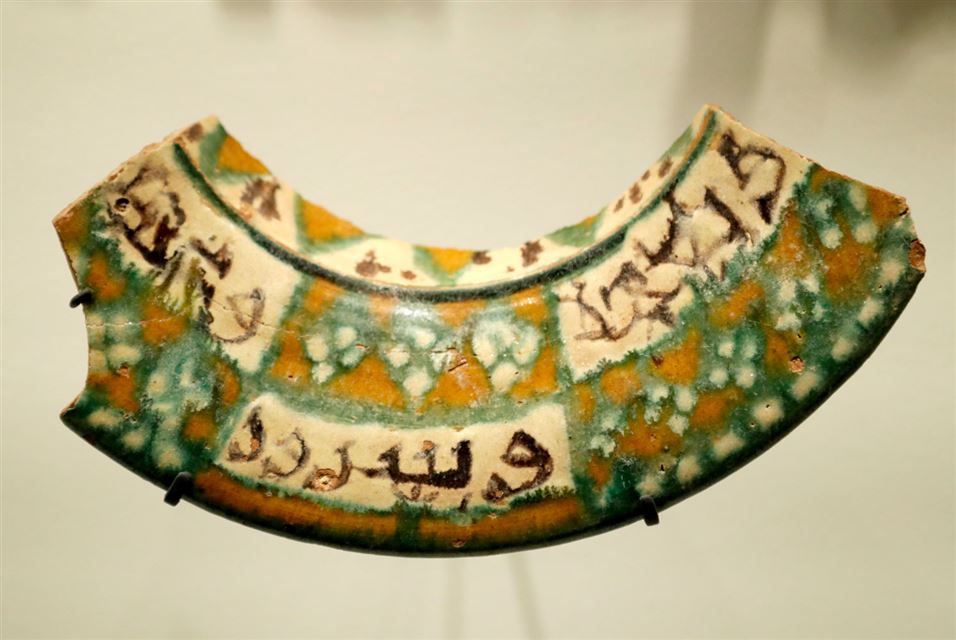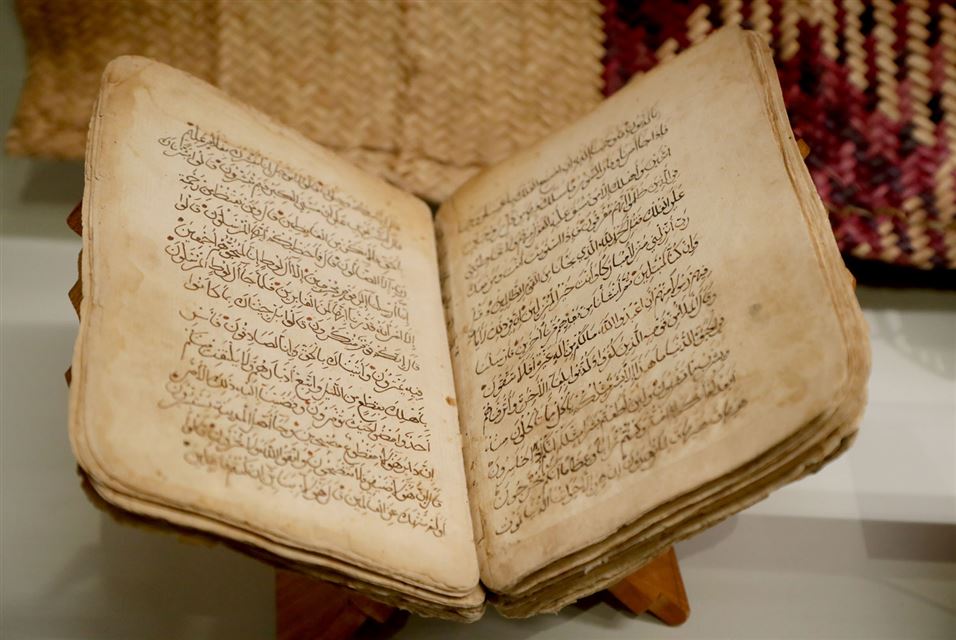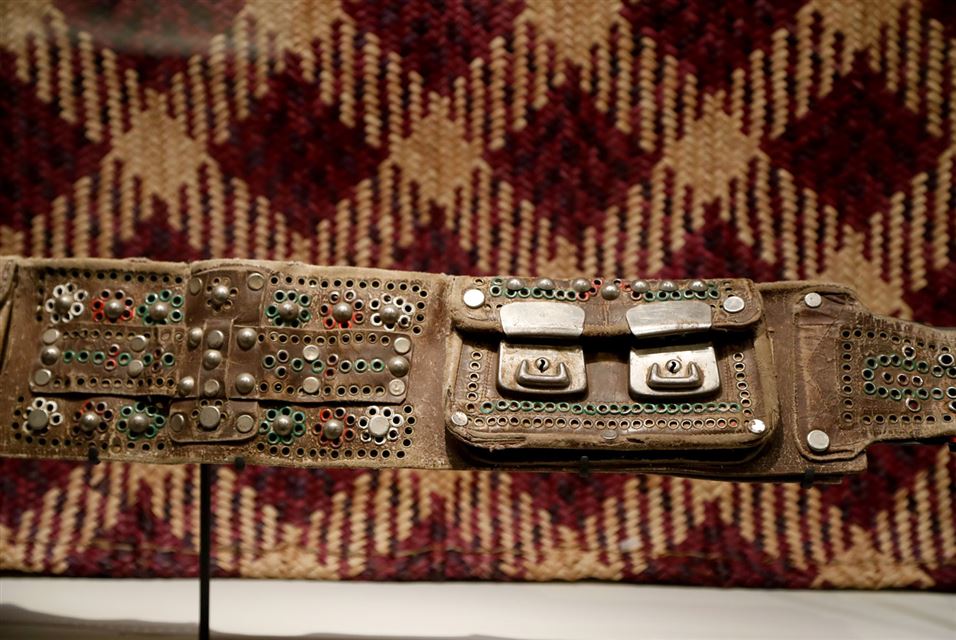![27]()
Masque en pierre, détail, Culture Teotihuacan, Vallée de Mexico, Classique, 450-650 AP. J.-C., estimation : 125.000 – 175.000 €. Courtesy Sotheby's.
PARIS - Sotheby’s a l’honneur d’annoncer, sous le titre Le Soleil de nuit, Trésors précolombiens d’une grande Collection française, la vente qui se tiendra à Paris le 30 octobre prochain. Cet ensemble majeur de 75 oeuvres d’art précolombien témoigne du goût éclairé d’un grand collectionneur français dont l’art imprégna littéralement la vie. Issues de sa succession, elles côtoyaient tant des spécimens d’histoire naturelle que des chefs-d’oeuvre d’arts décoratifs des XVIIe et XVIIIe siècles, du design et de l’art moderne.
PARIS.- Sotheby’s Paris will present the auction Le Soleil de Nuit, Trésors Précolombiens d’une Grande collection Francaise, on October 30. The collection is from the estate of a lifelong collector whose well tuned eye assembled art of many eras and styles, from masterpieces of 17th and 18th decorative arts, natural history, to 20th design and modern art. The 75 works of Pre-Columbian fit comfortably in his domain, reflecting his passion for quality, beauty and the soulful element of fine objects.
La collection se distingue par un exceptionnel ensemble de quatre masques de Teotihuacan, dont les traits et les pierres respectives - tecali lumineux (l’albâtre mexicain), la roche verte et la serpentine - traduisent les nuances sensibles de cet illustre corpus de visages idéalisés. Deux d’entre eux provenant de collections privées américaines constituées dans les années 1950 et 1960, avaient été exposés à l’Art Institute de Chicago (estimations : 125.000 – 175.000 € et 100.000 – 150.000 €).
The collection is distinguished by a group of four Teotihuacan stone masks, in both luminous tecali, (the Mexican alabaster), and dark greenstone and serpentine, each visage conveying an individual element within the corpus of these idealized faces. Two of the masks were formerly in private American collections of the 1950’s and 1960’s, and exhibited at the Art Institute of Chicago (estimates: €125,000 – 175,000 and €100,000 – 150,000).
![27]()
![27]()
![27]()
![27]()
Lot 27. Masque en pierre, Culture Teotihuacan, Vallée de Mexico,Classique, 450-650 AP. J.-C.; haut. 20 cm ; 8 in. Estimate: 125,000 — 175,000 EUR. Courtesy Sotheby's.
Provenance: Collection M. et Mme Julian R. Goldsmith, Chicago, acquis ca. 1960
Chicago, The Art Institute of Chicago (inv. n° 1991.469)
Sotheby's, New York, 11 mai 2012, n° 39, vendu par The Art Institute of Chicago
Importante Collection privée française
Exhibited: Chicago, The Arts Club, High Culture in the Americas Before 1500, 15 novembre - 31 décembre 1982
Chicago, The Art Institute of Chicago, collections permanentes, 1992-2012
Literature: McNear (E.), High Culture in the Americas before 1500, The Arts Club, Chicago, 1982, p. 34, n° 68
Note: Icônes de l’art précolombien, les masques originaires de la cité de Teotihuacan sont universellement reconnus pour leur beauté empreinte d’une très grande sérénité. Fait exceptionnel, cette importante collection française réunit quatre de ces masques qui, bien que tous façonnés selon le canon classique, illustrent chacun le génie individuel de l’artiste qui les a créés. Townsend parle ainsi de véritable « intention de portrait » lors de la création de ces masques dont les yeux et la bouche étaient souvent incrustés pour leur donner un souffle de vie, et les joues décorées de bandes incisées ou peintes pour les identifier (in Indian Art of the Americas, 2016, p. 177).
Ces masques n’étaient jamais portés par les hommes lors des cérémonies. Ils constituaient l’élément principal de grands décors faits d’éléments périssables et ornaient le visage de l’effigie du dieu célébré. Ces installations sont particulièrement lisibles sur les grandes peintures murales polychromes des palais Tetitla et Tepantitla à Teotihuacan. Chacun des masques qui ornaient les effigies était ainsi identifiable et assimiléà un dieu précis. Contrairement aux grandes effigies de pierre qui ornaient les temples, ces masques étaient transportables et pouvaient ainsi participer aux cérémonies de tous les grands centres de la région.
Ce masque s’impose au sein du corpus par les reliquats de pyrite et de pigments qui confèrent une coloration distincte à son regard et affirment son caractère individuel. S’ajoutent les bandes étroites incisées le long des joues, signes de l’âge de la personne représentée. Par l’ensemble de ses qualités esthétiques et par les caractéristiques physiques de la pierre utilisée, il s’apparente étroitement au masque en pierre du célèbre collectionneur anglais Jacob Epstein; voir Bassani et McLeod, Jacob Epstein Collector, 1989, p. 164, n° 677.
Pour d’autres masques de ce style, voir Berrin et Pasztory, Teotihuacan, 1993, p. 185 n° 24 et p. 187, n° 26.
The masks of Teotihuacan are one of the most recognized icons of Pre-Columbian art, imbued with a universal serenity. Each of the four masks within this collection can be considered of the classic idealized form yet each has its own subtle individual character. Townsend notes the ‘intention of portraiture’, whereby masks had inlay for the eyes and mouth, and some with inset bands on the cheeks, or painted stripes on the face (Townsend, Indian Art of the Americas, 2016, p. 177).
The masks were never to be worn for human performance. They served as the central feature within the elaborate accoutrements of perishable material on the festival effigy figures, as seen in the polychrome murals at compounds in Teotihuacan in Palace of Tetitla and Tepantitla. The masks and effigy figures were likely customized to represent the appropriate deity celebrated. Unlike large complete stone figures which may have been more fixed to one location, the masks could be transported for ceremony throughout the city and region.
The wideset eyes show the distinct staining and remains of pyrite and pigment, adding to its individual character along with the narrow bands of age lines curving along the cheeks. The overall design and proportion of this face are similar to the Teotihuacan stone mask from the renown English collector Jacob Epstein; see Bassani and McLeod, Jacob Epstein Collector, 1989, p. 164, no. 677.
For other masks of the type see Berrin and Pasztory, Teotihuacan, 1993, p. 185, no. 24 and p. 187, no. 26
![d5655c84eb8bfd5e0abfaeb7b0caa9d1]()
![H0046-L186489703_original]()
![9ea66e62a0089a4d8adf6a614736c58f]()
Lot 29. Masque en pierre tecali, Culture Teotihuacan, Vallée de Mexico, Classique, 450-650 AP. J.-C.; larg. 19 cm ; 7 1/2 in. Estimate: 100,000 — 150,000 EUR. Courtesy Sotheby's.
Provenance: Collection M. et M me Samuel A. Marx, Chicago
Chicago, The Art Institute of Chicago, 1958 (inv. n° 58.323 )
Sotheby's, New York, 11 mai 2012, n° 42, vendu par The Art Institute of Chicago
Importante Collection privée française
Exhibited: Chicago, The Art Institute of Chicago, collections permanentes, 1960-2012
Note: Ce très beau masque Teotihuacan est sculpté en tecali (onyx) de couleur jaune apprécié pour ses nuances de couleurs allant du blanc translucide au jaune teinté de vert comme c'est le cas ici. Cette pierre est originaire de la région de Puebla. Le visage s’inscrit dans un triangle à la pointe arrondie qui lui donne une certaine douceur. Sous un haut front fuyant et une ligne de sourcils très légèrement marquée, deux cavités ovales représentent les yeux à l’origine incrustés de pyrites ou de coquillage. Le nez à l’arête très fine s’élargit pour former un parfait triangle. Les lèvres épaisses encadrent la bouche légèrement ouverte et qui était incrustée de coquillages blancs pour figurer les dents.
Un fragment de masque tecali de la collection Dumbarton Oaks montre des reliquats de textile sur le front, indiquant la vulnérabilité de ce matériau et étayant la théorie de la fixation de masques avec un emballage sophistiqué de matériaux périssables (Evans, Ancient Mexican Art at Dumbarton Oaks, 2010, p. 50-51, pl. 14).
Il existe un masque tecali vert pâle inventorié dans la collection d'Antoine de Médicis après son décès en 1621, et aujourd'hui conservé au Museo degli Argenti à Florence - voir Moctezuma et Olguin, Aztèques, 2002, p. 404, n° 12 et n° 824.
Voir aussi les masques en tecali publiés par Pasztory dans Teotihuacan, 1993, pp. 189-191, n° 29 et n° 30 conservés au Museum für Völkerkunde, Vienne (14685, 6250); n°. 31 au University Museum, University of Pennsylvania (66.27.14); n° 32 de la Yale University Art Gallery (1980.13.12); et n° 33 à The Art Museum, Princeton University (L.1970.44).
The beautiful mask is carved in tecali, a calcite known as Mexican onyx and prized for the colors ranging from translucent white to a pale lime-green as in this example. One source of tecali stone was from the Puebla region. The face is carved in a triangular form with a rounded chin that imbues a gentle softness. The high forehead is marked by fine eyebrows and the recessed eyes were once inlaid with pyrite or shell. The nosebridge expands to a form a perfect triangle and the full lips are slightly open, once inlaid with white shells forming the teeth.
A tecali mask fragment in the Dumbarton Oaks collection shows remains of textile impression on the forehead, indicating the vulnerability of this material and supporting the theory of masks being attached with the elaborate wrapping of perishable material (Evans, Ancient Mexican Art at Dumbarton Oaks, 2010, pp. 50-51, pl. 14).
For a lime-green tecali mask inventoried in Antonio de Medici's collections at the time of his death in 1621, now in the Museo degli Argenti, Florence, see Moctezuma and Olguin, Aztecs, 2002, p. 404, no. 12 and no. 824.
See also the tecali masks in Pasztory, Teotihuacan, 1993, pp. 189-191, nos. 29, 30 in the Museum für Völkerkunde, Vienna (14685, 6250); no. 31 in the University Museum, University of Pennsylvania (66.27.14); no. 32 in Yale University Art Gallery (1980.13.12); and no. 33 at The Art Museum, Princeton University (L.1970.44).
![31]()
![31]()
![31]()
Lot 31. Masque en serpentine, Culture Teotihuacan, Vallée de Mexico, Classique, 450-650 AP. J.-C.; haut. 19 cm ; 7 1/2 in. Estimate: 100,000 — 150,000 EUR. Courtesy Sotheby's.
Provenance: Collection Raul Kampfer, New York, acquis en 1940
Collection Jean-Louis Sonnery, Paris, acquis en 1950
Collection Gérald Berjonneau, Paris, acquis en 1980
Castor Hara, Paris, 3 juin 2013, n° 48
Importante Collection privée française
Exhibited: Paris, Fondation Cartier, A visage découvert, 19 juin - 4 octobre 1992
Genève, Musée Rath, Mexique, terre des dieux : trésors de l'art précolombien, 8 octobre 1998 - 24 janvier 1999
Literature: Berjonneau (G.), Sonnery (J.-L.) et Deletaille (E.), Chefs-d'œuvre inédits de l'art précolombien, 1985, p.116, n° 151
Kerchache (J.), A visage découvert, 1992, dos de couverture
Burnand (G.), Mexique, terre des dieux : trésors de l'art précolombien, 1998, p. 131, n° 138
Aveleyra (L.), Pina Chan (R.), L'art précolombien : Olmèque - Maya - Aztèque, 2000, p. 203
Stierlin (H.), Teotihuacan. La cité des Dieux, 2009, n. p.
Note: Ce remarquable masque en serpentin noire ; le plus imposant des quatre masques de la collection ; affirme une force particulière transmise par son équilibre formel et sa couleur profonde. Il illustre la "beauté sévère" qu’Evans évoque dans ses commentaires sur les masques de la collection Dumbarton Oaks (Evans, Ancient Mexican Art at Dumbarton Oaks, 2010, p. 44).
La dextérité des maîtres lapidaires de Teotihuacan est ici particulièrement visible dans la finition et la conception du visage. La coupe nette et confiante des sourcils forme des arcs parfaitement équilibrés qui répondent aux plans faciaux latéraux légèrement aplatis définissant les pommettes saillantes. La tranche pointue du nez contraste avec le léger philtrum au-dessus de la lèvre supérieure de la bouche sculptée. Le polissage rend le noir presque lumineux et renforce l’expression impassible de ce visage à la beauté intemporelle.
Les masques de Teotihuacan ne sont pas en eux-mêmes un élément de transformation dans la façon dont nous concevons les masques, mais fonctionnent dans le contexte d'un plus grand assemblage. Leurs rôles rituels prenaient vie lors des rites de fête et de cérémonie. Certains ont peut-être été attachés à des effigies et présentés lors de cérémonies occasionnelles pour consulter ou vénérer un esprit.
The dark serpentine masks of Teotihuacan emit a particular force and formal balance in the deeply sculpted arched browlines and modeled facial planes. A type of 'severe beauty ', it is the epitome of a restrained aesthetic. (Evans, Ancient Mexican Art at Dumbarton Oaks, 2010, p. 44).
The dexterity of Teotihuacan’s lapidary masters can be seen in the workmanship and design of the face. The sharp and confident carving of the brows form perfectly balanced arcs, the slightly flattened lateral facial planes define the high cheek bones, and the sharp bridge of the nose contrasts against the gentle philtrum above the upper lip of the sculpted mouth. The polishing makes the black almost luminous and reinforces the impassive expression of this timeless beauty face. It is a masterpiece of one aesthetic of the Teotihuacan mask tradition.
Teotihuacan masks are not in themselves the transformative element in the way we think of masks, but function within the context of a greater assemblage. The ritual roles they functioned in were part of festival and ceremonial rites. Some may have been attached to funerary bundles animating the effigy and displayed in occasional ceremonies to consult or venerate a spirit.
![34]()
Lot 34. Masque en tecali, Culture Teotihuacan, Vallée de Mexico, Classique, 450-650 AP. J.-C.; haut. 15 cm ; 5 7/8 in. Estimate: 60,000 — 80,000 EUR. Courtesy Sotheby's.
Provenance: Collection privée, Belgique
Collection Gérald Berjonneau, Paris, acquis en 1977
Importante Collection privée française, acquis du précédent en 2005
Note: Le deuxième masque en tecali de cette collection montre l’apothéose du blanc que l’on retrouve dans le spectre des couleurs de cette pierre. A sa translucidité laiteuse répondaient dans un contraste saisissant les incrustations des yeux et de la bouche, ainsi que les éléments du costume périssable de l’effigie dont ce masque ornait le visage.
Ce masque se distingue par un plan facial large et lisse, un menton aplati et des yeux ovales étroits. Il a pu être décoré avec de la peinture et des incrustations supplémentaires, comme semblent l’indiquer les zones légèrement rugueuses sur les joues. Il n'est pas rare de trouver des masques Teotihuacan avec des décorations sur les joues, allant de motifs géométriques à des décors beaucoup plus figuratifs tels que des fleurs.
Pour des masques de type similaire, voir Sotheby’s, New York, 15 mai 2017, n° 74, et Sotheby’s, New York, 16 mai 2014, n° 279.
The second of the two tecali masks of this collection, this mask shows the very white side of the spectrum of colors of tecali stone. With its milky translucent quality it would have been a bright palette against the inlays of the eyes and mouth, as well as the surrounding brilliant perishable costume elements of a ceremonial effigy figure.
The facial style is distinct for the broad and smooth facial plane and flattened chin with narrowed oval eyes. The face may have been decorated with paint or additional inlay as indicated by the slightly roughened areas on the cheeks. It is not uncommon to find Teotihuacan masks with decorations on the cheeks of geometric patterns or flowers representing face paint designs.
For similar masks of this type, see Sotheby’s, New York, May 15, 2017, no. 74, and Sotheby’s, New York, May 16, 2014, no. 279.
La culture olmèque, la plus ancienne des civilisations mésoaméricaines, est illustrée par deux oeuvres emblématiques. La première est une poignée de perforateur, prestigieux instrument cérémoniel utilisé par les dignitaires lors des rituels de saignée destinés à affirmer leur pouvoir lignager. Sculpté dans un jade bleu-vert, le plus prisé des matériaux, il représente l’homme-jaguar émergeant d’un épi de maïs. De la graine en germination s’élève la créature surnaturelle, mi-homme, mi-jaguar, évoquant en écho la naissance de la divinité du maïs, céréale essentielle à la vie (estimation : 200.000 - 300.000€).
The earliest culture of Mesoamerica is represented with two iconic Olmec objects, a perforator handle of the infant were-jaguar emerging from a split ear of maize. This ceremonial tool was important for the bloodletting ceremonies that rulers performed to affirm their lineage and rulership. From the germinating seed of the maize kernel rises the supernatural half-human, half-jaguar creature. This perforator is carved in blue-green jade, the most prized of ancient materials, and echoes the birth of the corn god from the verdant growth of lifesustaining maize (estimate: €200,000-300,000€).
![22]()
![22]()
![22]()
![22]()
Lot 22. Perforateur en jade, Culture Olmèque, Préclassique moyen, 900 - 600 AV. J.-C.; haut. 10,5 cm ; 4 3/8 in. Estimate: 200,000 — 300,000 EUR. Courtesy Sotheby's.
Provenance: Edward H. Merrin Gallery, New York
Collection privée, Paris, acquis ca. 1980
Sotheby's, New York, 17 mai 2007, n° 179
Importante Collection privée française
Literature: Berjonneau (G.), Sonnery (J.-L.) et Deletaille (E.), Chefs-d'œuvre inédits de l'art précolombien , 1985, p. 36, n° 8
Taube (K. A.), Olmec Art at Dumbarton Oaks, 2004, p. 90, n° 41a, dessin.
Note: Cette puissante représentation de l’homme-jaguar constituait la poignée d’un perforateur sacré, autrefois sertie d’une longue lame conique. L’homme-jaguar émergeant d’un épi de maïs fendu symbolise, dans une dynamique d’élan vertical, une posture de croissance éternelle. La sculpture invite ainsi le spectateur à anticiper et àêtre témoin de l’émergence ultime de la divinité. Sa forme diminutive éloquente témoigne de son importance rituelle et de la magistrale dimension expressive et narrative de l'art olmèque. Il s’agit de la plus ancienne représentation de l’infant homme-jaguar, incarnation du Dieu du maïs, l’une des divinités les plus puissantes et impérieuses peuplant la mythologie de l’ancienne Mésoamérique.
Brillamment ouvragé, ce perforateur s’inscrit dans l’infime corpus de quatre témoins répertoriés de l’infant homme-jaguar émergeant de l'épi fendu. Le corps doux et charnu contraste magistralement avec la dureté impénétrable du jade.
Les hommes-jaguars étaient omniprésents dans la mythologie et l'iconographie olmèques. Le jaguar était vénéré comme la créature la plus puissante du monde animal ; considéré comme le seigneur de la nuit, il fut finalement associéà la puissance politique, au pouvoir physique et divin. Dans certaines sculptures, les figures mi-humaines, mi-félines illustrent graphiquement la transformation chamanique de l'homme en animal, tandis que d’autres représentent des êtres humains portant des masques de jaguar. Chacune de ces formes traduit la puissance et le pouvoir de l'état transitoire. Ici, l’homme-jaguar se distingue par l'emblème surnaturel des lignes verticales scindant l'œil – iconographie qui le relie au dieu à l'œil bandé, l'une des principales divinités représentées sur la célèbre statue du Seigneur de Las Limas (Musée d’anthropologie de Veracruz, Xalapa). Il est exceptionnel que le dieu à l’œil bandé soit représenté sous les traits d’une figure en pied, comme ici (Joralemon in Benson et De La Fuente, Olmec Art of Ancient Mexico, 1996, p. 56).
Pour les Olmèques, la dynamique perpétuelle entre les mondes terrestre et surnaturel constituait l'équilibre crucial du pouvoir exercé par les dirigeants et les chamans.
La saignée, offrande d'un fluide vital sacré, était l'un des actes rituels les plus importants pratiquéà l’époque olmèque. Il se perpétua, de manière hautement cérémonielle, pendant toute la période maya. Cet acte de pénitence et de purification était aussi considéré comme l’offrande à la terre d’une nourriture métaphorique destinée à assurer des cultures fertiles. Les artéfacts utilisés pour la saignée étaient réalisés dans des éléments naturels tels que des aiguillons de raie, des pointes de cactus ou encore des dents de requin. Leur typologie fut étudiée lors de missions scientifiques sur le site de La Venta, au cœur du territoire olmèque, et dans d’autres régions du pays olmèque.
“[La] création d'objets dotés d’un pouvoir magique, ouvragés dans des matériaux précieux et exotiques et utilisés lors de performances rituelles donnaient une forme visible aux pouvoirs chamaniques des dirigeants olmèques, agissant comme validation de leur revendication de pouvoir.” (Coe et al., Olmec World, 1995, p. 163).
Pour les trois autres perforateurs ornés d’une représentation de l’homme-jaguar, voir idem, pl. 76; Berjonneau, Deletaille et Sonnery, Chefs-d'œuvre inédits de l'art précolombien, 1985, fig. 5; et un exemplaire non reproduit conservé dans une collection privée américaine, cité par Joralemon dans Le Fort, Masters of Americas, Janssen Collection, 2005, p. 26. Joralemon souligne que le concept olmèque d'un être surnaturel émergeant d'une plante fut adopté comme forme sculpturale dans les figures Jaina des Mayas.
Pour un manche de perforateur en jade apparenté dans la collection de Dora et Paul Janssen, voir Le Fort, op. cit., p. 27.
"La culture olmèque a cristallisé avec cohérence et puissance les principes fondamentaux qui imprègnent la pensée mésoaméricaine " (Magaloni in Berrin et Fields, Olmec Colossal Masterworks, 2010, p. 10).
The powerful figure of the supernatural were-jaguar is the handle to a sacred perforator once with a long tapered shaft. The fully sculpted figure emerging from the cleft maize ear is in a dynamic position: the sculpture engages and holds our anticipation of witnessing the final appearance of the full deity. The perforator handle conveys the intensely expressive and narrative ability of Olmec art in a small ritualized object. This is the earliest graphic depiction of the were-jaguar infant representing the Maize God, one of the most omnipotent and dominant deities to pervade ancient Mesoamerica mythology.
This finely carved perforator is one of only four examples of the infant were-jaguar emerging from the cleaved stalk of the plant. The were-jaguar’s soft fleshy body is masterfully juxtaposed to the impenetrable hardness of the jade.
Were-jaguars were the most prevalent creature of Olmec mythology and iconography. The jaguar was revered as the most powerful creature of the animal world; it was the lord of the night and ultimately associated with political might and physical and divine power. In some depictions, the half-human, half feline figures graphically show the shamanic transformation of man into an animal, in other sculptures they are humans wearing jaguar masks. But in all forms, they convey the potency and power of the transitory state. This were-jaguar is distinguished by the supernatural insignia of vertical lines bisecting the eye, and thus it is connected to the banded-eye god, one of the principal deities incised on the Las Limas seated figure, a virtual Rosetta stone of the Olmec pantheon of deities. Interestingly, the banded-eye god is never shown as a full figure, as rendered here (Joralemon in Benson and De La Fuente, Olmec Art of Ancient Mexico, 1996, p. 56).
For the Olmec, the continual dynamic between the natural and supernatural world was the crucial balance of power that was maintained by the rulers and shaman. Bloodletting, the offering of vital sacred fluid, was one of the most important acts that were practiced from Olmec times and continued in elaborate ceremonies through the Maya period. It was an act of penitence and purification, but also a metaphoric nourishing of the earth to help ensure fertile crops.
Bloodletters were made from natural objects such as stingray spines, cactus points, and sharks teeth. Blood letters of various types have been scientifically excavated at La Venta in the Olmec heartland area and other areas of the Olmec region.
“[The]…creation of magically empowered objects of precious and exotic materials animated in ritual performance gave visible form to the shamanic powers of Olmec rulers as a validation to their claim of rulership.” (Coe et al., Olmec World, 1995, p. 163).
For the three other perforators with were-jaguar figures, see (ibid: pl. 76); Berjonneau, Deletaille and Sonnery, Rediscovered Masterpieces, 1985, p. 36, fig. 5; and an unpublished example in an American private collection as cited by Joralemon in Le Fort, ed. Masters of the Americas, Dora and Paul Janssen Collection, 2005, p. 26). Joralemon also notes that the Olmec concept of a supernatural being issuing from a plant became a sculptural form in the ceramic Jaina figures for the Maya.
For a related jade perforator handle, see the jade perforator in the Dora and Paul Janssen Collection, Le Fort, ed. op. cit., p. 27.
"Olmec culture coherently and powerfully crystallized fundamental principles that pervade Mesoamerican thought." (Magaloni, in Berrin and Fields, Olmec Colossal Masterworks, 2010, p. 10).
La seconde est un masque miniature en pierre au visage empreint de sagesse, finement incisé d’images symboliques des divinités olmèques. Il fut exposé en 1969 au Museum of Primitive Art (New York), dans l’une des plus importantes expositions jamais consacrées à l’art précolombien : Precolumbian art in New York, Selections from Private Collections.
An Olmec stone maskette with the soulful face of humility and wisdom is finely incised with symbolic imagery of the Olmec deities. It was published and exhibited in 1969 at the Museum of Primitive Art, New York, in one of the important exhibitions devoted to Pre-Columbian art, Precolumbian art in New York, Selections from Private Collections.
![23]()
![23]()
Lot 23. Masquette en pierre, Culture Olmèque, Préclassique Moyen 900-600 AV. J.-C.; haut. 8 cm ; 3 1/8 in. Estimate: 150,000 — 200,000 EUR. Courtesy Sotheby's.
Provenance: Collection Miles et Margaret Lourie, New York, acquis ca. 1960
Christie's, Paris, 14 juin 2004, n° 375
Importante Collection privée française.
Exhibited: New York, Museum of Primitive Art, Pre-Columbian Art in New York: Selections from Private Collections, 12 septembre - 9 novembre 1969
Literature: Jones (J.), Pre-Columbian Art in New York: Selections from Private Collections, 1969, n° 3.
Note: Les masques en pierre de la culture olmèque sont des sculptures primordiales de l’époque Préclassique Moyenne. Ils constituent l'un des médias privilégiés par lequel les artistes olmèques produisaient des insignes de pouvoir en s'appuyant sur un système iconographique hautement symbolique et normalisé. Les masques olmèques sont réputés pour l’incroyable émotion qu’exalte leur visage.
Cette masquette faisait office de pendentif; finement modelée, elle est sculptée avec la même technicité que les grands masques en jade de la même époque. Ces ornements miniatures étaient vraisemblablement portés autour du cou, à la ceinture ou dans les falbalas de la coiffure.
Le visage arbore une petite bouche en creux faisant écho aux yeux en amande, presque plissés par le gonflement des paupières inférieures. La bouche relâchée aux lèvres sensuelles laisse apparaître le liseré gingival.
De forme naturaliste, le visage est gravé d'emblèmes symboliques divins indiquant un état transitoire. Le côté gauche du front est légèrement incisé de la tête de l'homme-jaguar, l'un des esprits surnaturels fondamentaux du panthéon olmèque. L'infant homme-jaguar est plus particulièrement associé aux puissantes énergies de la pluie et du maïs. Lorsqu'elle est présentée de face, la tête de l'homme-jaguar est généralement dotée de grands yeux en amandes et d'un visage triangulaire fendu. Si la fente peut être une représentation du sillon d’une tête de jaguar ou de la fontanelle d’un nouveau-né, elle est plus vraisemblablement l'image de la terre se fissurant lors de la pousse du maïs (Coe et al., Olmec World, 1995, p. 154).
Cette miniature impose toute la monumentalité de l’art olmèque, apte à traduire, dans la représentation d’un individu sans âge et asexué, la prégnance d’une conscience mystique. Pour un autre masque incisé du même style, voir Coe et al. (idem, p. 153, n° 25) ; pour un grand masque en jade minutieusement incisé avec l'image de l'homme-jaguar de face et de profil, voir Benson et De La Fuente, Olmec Art of Ancient Mexico, 1996, p. 235, n° 77.
Olmec masks were an important stone sculpture form during the Middle Preclassic era. They represent one of the predominant expressions of how the Olmec artist created an empowered object with symbolically charged standardized imagery. The masks are notable for the pathos conveyed in their seemingly otherworldly expressions.
This maskette used as a pendant is finely modeled and carved with the same craftsmanship exerted on lifesize jade masks of the era. The small portable sculptures drilled to be worn as ornaments could have been a necklace pendant or in the layers of belt or headdress paraphernalia.
The face is carved with a deeply recessed downturned mouth that echoes the shape of the almond-shaped eyes which are nearly raised to a squint by the swelling lower lids. The relaxed sensual lips reveal the inner gum.
While naturalistic in form, the human face is incised with a symbolic deity emblem that signifies a transitory state. The proper left side of the forehead is gently incised with the frontal head of the were-jaguar, one of the most important supernaturals of the Olmec pantheon. The infant were-jaguar is most closely associated with the supreme forces of rain and life-sustaining maize. The were-jaguar face in frontal form is typically shown with upturned almond-shaped eyes and the V-shape cleft head. It has been suggested the cleft represents the furrow of a jaguars head or the fontanel of a newborn baby's head, but it has been most closely associated with the break in the earth during the emergent maize ear (Coe et al., Olmec World, 1995, p. 154).
It is a powerful depiction in small scale of an ageless and sexless being with an otherworldly consciousness by the imprint of the deity head. For another incised maskette of this type, see Coe et al, eds. op. cit. p. 153, cat. no. 25; for a life-size jade mask elaborately incised with the were-jaguar image in frontal and profile form, see Benson and De La Fuente, Olmec Art of Ancient Mexico, 1996, p. 235, no. 77.
Le raffinement de la culture Maya s’impose dans des objets de facture remarquable en jade, en céramique ou en pierre. Ses récits mythologiques se déploient avec la plus grande élégance sur le vase codex représentant le jeune dieu du maïs dans l’attitude du scribe, sur des réceptacles polychromes ou en céramique à laque noire, sur de délicats pendentifs en jade vert-pomme et des silex (estimation : 100.000 - 150.000 €).
The Maya culture is well represented in jade, ceramic and stone objects of refined workmanship and design. The Maya vase of codex of the Young Maize god as a scribe,) gracefully depicts this deity in the act of writing. The narratives of Maya mythology are also shown on polychrome cylinder vessels, lustrous blackware ceramic vessels, delicate stone pendants in apple-green jade, and the abstract ‘eccentric’ flints (estimate: €100,000 – 150,000).
![56]()
![56]()
Lot 56. Vase de type Codex, avec Scribes, Culture Maya, Classique Récent, 550-950 AP. J.-C.; haut. 12 cm ; 4 3/4 in. Estimate: 90,000 — 120,000 EUR. Courtesy Sotheby's.
Provenance: Collection privée, États-Unis, acquis en 1970
Sotheby's, New York, 12 mai 2005, n° 300
Importante Collection privée française.
Exhibited: Durham, North Carolina, Duke University Museum of Art, Painting the Maya Universe : Royal Ceramics of the Classic Period, 15 janvier - 27 mars 1994 / Boston, Museum of Fine Arts, 15 avril - 26 juin 1994 / Denver, Denver Art Museum, 15 juillet - 15 septembre 1994 / Los Angeles, Los Angeles County Museum of Art, 8 octobre 1994 - 8 janvier, 1995 / New Haven, Yale University Art Gallery, 10 février - 23 avril 1995.
Literature: Robicsek (F.) et Hales (D. M.), The Maya Book of the Dead, The Ceramic Codex, 1981, couverture et p. 58, n° 69
Reents-Budet (D.), Painting the Maya Universe: Royal Ceramics of the Classic Period, 1994, p. 37 fig. 2.2 pour le détail; p. 45 fig. 2.13b pour le détail du dessin, et p. 316, n° 4
Coe (M. D.) et Kerr (J.), The Art of the Maya Scribe, 1998, p. 107, n° 76
Kerr (J.), mayavase.com, n° K1185.
![56]()
L’art de l’ancien Mexique occidental s’illustre tant dans sa tradition délicate de la céramique, avec la poétique figure féminine Chinesco, assise dans une calme méditation, que dans la pierre (estimation : 60.000 - 80.000€). A côté de deux hachas, en forme d’humain et d’oiseau, s’impose un joug cérémoniel en pierre sculpté d’un serpent et de formes félines, symbolisant la ceinture en cuir et en textile portée par les joueurs de balle – sport rituel pratiqué pendant des millénaires en Mésoamérique.
The refined ceramic tradition of ancient West Mexico is most poetically shown in the demure seated Chinesco female figure, poised in tranquil meditation (estimate: €60,000-80,000). The ballgame was one of the most important rituals of sport and prowess played throughout the millennia in ancient Mesoamerica. The collection features a stone effigy yoke from an early French collection, carved with a serpent and images of skeletal and feline forms. Yokes were the ceremonial version of the actual leather and textile belts worn by the players. The collection also includes two ballgame hachas in human and bird form.
![35]()
![35]()
Lot 35. Statue anthropomorphe assise, Culture Nayarit, Style Lagunillas Type E, Protoclassique, 100 AV. J.-C. - 250 AP. J.-C.; haut. 32,5 cm ; 12 3/4 in. Estimate: 60,000 — 80,000 EUR. Courtesy Sotheby's.
Provenance: Collection privée, États-Unis, acquis en 1972
Sotheby's, New York, 9 mai 2006, n° 170
Importante Collection privée française.
Note: Les statues "Chinesco" - ainsi fréquemment nommées pour leur supposée analogie stylistique avec l'art oriental - originaires de la région de Lagunillas (au Sud des Nayarit), comptent parmi les statues funéraires les plus évocatrices de l’Ouest mexicain. Agenouillé, les bras recourbés sous l’ample poitrine, le personnage féminin nous apparaît dans une transe profonde, d'une intense sérénité. Son iconographie évoque le « rituel de la nudité» qui, selon Townsend, constituait pour les jeunes femmes un rite initiatique (Townsend, Ancient West Mexico, 1998, p. 122).
La typologie des statues Nayarit distingue cinq sous-ensembles (A-E) et cette statue féminine relève du type E. Elle est sobrement décorée de peinture rouge et arbore une « main rouge » sur la poitrine, la joue et l'omoplate, ainsi qu’une délicate ceinture perlée soulignant la taille. La teinte crème subsistante qui souligne les cuisses indique la présence d’un pagne. Les traits du visage triangulaire sont moins prononcés que sur les autres styles et mettent en valeur les yeux gonflés, fendus, subtilement accentués par un masque noir. Elle est parée d’une perle nasale et d’une coiffure striée de fines lignes. Les traits de cette œuvre sont caractéristiques du style et intrinsèquement différents des autres types Nayarit, suggérant que les statues de type E ont pu être ouvragées par des ateliers individuels.
Pour des statues comparables, voir Townsend, idem, p. 284, n° 214 et 215, et Sotheby’s, New York, 7 mai 2016, n° 135.
"Chinesco" figures, as they are often designated, originating from the southern Nayarit region of Lagunillas, are some of the most evocative West Mexican funerary figures. Seated in a kneeling position with her arms underneath her wide-set breasts, she is in a deep trance, bearing a gentle but intense demeanor. Townsend refers to the 'ritual of nudity' as part of the young females' rite of passage (Townsend, Ancient West Mexico, 1998, p. 122).
There are five varieties of this Nayarit style; this female is typical of Type E. She is decorated sparingly with red paint and bears a ‘red hand’ on her breast, cheek and back shoulder, and wears a delicate beaded belt around her waist. A resist cream color demarcates her thighs, indicating the presence of a loincloth. The features on her slightly triangular face are less flat than other styles and exhibit puffy, slit eyes. A black mask lightly highlights the area around the eyes and she wears a small nose bead and has pierced ears. Thin, incised lines demarcate this figure’s coiffure. The distinctive traits representative of this type of figure are internally consistent and significantly different from other Nayarit types, perhaps indicating that they were manufactured at individual workshops.
For similar figures, see Townsend, ibid.,p. 284, no. 214 and 215; see also Sotheby’s, New York, May 7, 2016, lot 135.
Le champ de la collection s’étend aux ornements d’or et de jade d’Amérique Centrale et jusqu’à la riche tradition artistique de la région andine. Cette dernière excella dans la métallurgie, illustrée ici par une rare figure en argent Chimu, exposée au Metropolitan Museum of Art en 2000, et par le textile, avec une éblouissante tunique Wari tissée en registres abstraits de messagers à tête de puma.
The breadth of the collection extends into Central American gold and jade with finely necklaces and pendants. The rich tradition of metallurgy and textile art from the Andean region are shown with a rare Chimu silver figure, exhibited at the Metropolitan Museum of Art in 2000, and a dazzling Wari complete textile tunic woven with bands of abstract pumaheaded messenger figures.
![57]()
![57]()
Lot 57. Figurine en argent et métal, Culture Chimu, 1100-1300 AP. J.-C.; Argent (800°/00) et métal; Poids brut : 184,95 g; haut. 21 cm ; 8 1/4 in. Estimate: 80,000 — 120,000 EUR. Courtesy Sotheby's.
Provenance: Marché de l’art, Europe, ca. 1960
Collection privée scandinave
Sotheby's, New York, 24 novembre 1986, n° 9
Collection Eugene Chesrow, Chicago
Christie's, Paris, 12 juin 2003, n° 513
Importante Collection privée française.
Exhibited: New York, The Metropolitan Museum of Art, Rain of the Moon, Silver in Ancient Peru, 3 novembre 2000 - 22 avril 2001.
Literature: King (H. T.), Butters (L. J. C.) et de Mufarech (P. C.), Rain of the Moon, Silver in Ancient Peru, 2000, p. 38, n° 10
Mufarech (P. C.), The Silver and Silversmiths of Peru, 1997, p. 16, frontispice.
Chimu et l'art de la métallurgie de l'argent
Heidi King, historienne de l'art précolombien
Ce réceptacle extrêmement rare et original représente un homme allongé sur le ventre, les bras croisés à l’avant de la tête formant la coupe. Il est l’œuvre des Chimú, peuple qui régna sur la côte septentrionale du Pérou, du XIIIe siècle jusqu'à la conquête des Incas à la fin du XVe siècle. Les Chimú ont perpétué de nombreuses traditions établies par les cultures déjà présentes dans la région depuis plusieurs milliers d'années, notamment la création de vases anthropomorphes en argile, en bois et en métaux précieux tels que l'argent et l'or. Certains de ces réceptacles anthropomorphes figurent la moitié ou une partie du corps telle que la tête, les bras, les mains, les jambes ou les pieds, et sont représentés en posture assise, agenouillée ou debout. Ces réceptacles étaient utilisés lors de rituels et de cérémonies impliquant la consommation de boissons telles que la chicha. Ils étaient ensuite enterrés avec des personnalités de haut rang dans des tombeaux sophistiqués ou encore placés dans des niches comme offrandes aux dieux ou aux ancêtres. Les vases dont la silhouette complète adopte cette posture sont très rares et leur signification demeure inexpliquée. Quelques exemples en céramique de la culture Vicús, qui s’est épanouie sur la côte nord du Pérou plus de mille ans avant les Chimú, ont été répertoriés. Un certain nombre de vases en argile présentant des petits personnages dans cette position ont été exhumées de la tombe d'un haut dignitaire Sicán, prédécesseurs des Chimú, à Batan Grande, dans la vallée de Lambayeque, également située sur la côte nord. Ces découvertes confirment que pendant des siècles, cette position devait être hautement significative pour les cultures de cette région.
Les Chimú construisirent la capitale de leur royaume à Chan Chan, située à l'embouchure de la vallée de Moche (à la périphérie de l’actuelle Trujillo). À la fin du XVe siècle, la ville couvrait une superficie de plus de vingt kilomètres carrés, en faisant ainsi la plus grande cité de l'ancien Pérou.
En son centre, dix monumentaux complexes royaux appelés ciudadelas (petites villes) étaient entourés des quartiers résidentiels de la petite noblesse et de vastes quartiers d'artisanat de produits de luxe. Ce réceptacle a probablement été créé dans un atelier de métallurgie spécialisé. Les métallurgistes de Chimúétaient si accomplis dans leur métier que les Incas, après avoir conquis leur territoire, ont envoyé les meilleurs d'entre eux dans leur capitale Cuzco, sur les hauts plateaux du sud, pour servir la royauté Inca.
Une grande partie de l'or et de l'argent travaillés par les Chimúétait transformée en contenants plutôt qu'en ornements individuels, comme sous la domination Moche quelques siècles auparavant.
Ce réceptacle est constitué de onze feuilles d’argent de formes diverses, assemblées ou reliées par soudure. Le personnage est vêtu d’un simple pagne - visible sous le récipient - décoré d'un motif repoussé en pointillé et en zig-zag. Le haut du corps est nu. Sa tête dressée formant la coupe est coiffée d’un grand bonnet uni, maintenu par une mentonnière et bordé d’un alliage en or. L'alliance d'or et d'argent dans un même objet possédait une symbolique profondément enracinée dans le Pérou précolombien : le principe de dualité, de réciprocité et d'équilibre entre les contraires. L’or était considéré comme les larmes du soleil, et l’argent comme la pluie de la lune. Les doigts et les orteils sont en métal repoussé, tout comme les traits du visage, accentuant ainsi la proéminence des yeux rhomboïdaux grands ouverts.
Pour des réceptacles similaires en céramique, voir Makowski, Krzysztof et al., Vicús. Colección Arte y Tesoros del Perú, 1994, fig. 328 à 330.
Chimu, and the Art of Silver Metallurgy
Heidi King, Art Historian, Pre-Columbian Art
This very unusual and rare vessel is in the shape of an outstretched male figure lying on his stomach with crossed arms in front of his removable head which is open from the neck into the body which forms the container. It was made by the Chimú people who ruled over the North Coast of Peru from the 13th century until they were conquered by the Inca in the late 15th century. The Chimú continued many of the traditions established by earlier cultures in the region several thousand years before them, which included the manufacture of vessels in the form of human beings in a variety of materials such as clay, wood and precious metal like silver and gold. Many of these vessels show the human form – sometimes only half figures or only the head or body parts like arms, hands, legs or feet - in various poses, seated, kneeling, or standing. The vessels were used in rituals and ceremonies which involved the consumption of beverages such as chicha, and were subsequently buried with important individuals in elaborate tombs or placed in caches as offerings to the gods or ancestors. Full-figure vessels in this posture are very rare and its meaning remains unexplained. A few ceramic examples are known from the Vicús culture which flourished on Peru’s North Coast more than one thousand years prior to the Chimú. A number of clay vessels displaying small figures in this positon were excavated from a rich elite burial of the Sicán people, predecessors of the Chimú, at Batan Grande in the Lambayeque Valley, also on the North Coast. This suggests that this posture of the human figure had significant meaning over many centuries on the North Coast of Peru.
The Chimú built the capital city of their kingdom at Chan Chan located at the mouth of the Moche Valley on the outskirts of the modern town of Trujillo. By the late fifteenth century the city covered eight square miles and was the largest in ancient Peru. Its core consisted of ten monumental royal compounds known as ciudadelas (little cities), surrounded by residences for the lesser nobility as well as sprawling quarters of artisans engaged in the manufacture of luxury goods. This vessel was probably made in a specialized metalworkers workshop. Chimú metalworkers were so accomplished in their craft that the Inca, after conquering their territory, relocated the best of them to their capital city of Cuzco in the southern highlands, to work for Inca royalty.
Much of the gold and silver worked by the Chimú was shaped into containers of various kinds rather than into personal adornments as was the case during Moche dominance of the region many centuries earlier. The vessel is made of eleven separately shaped pieces of sheet silver which have been tabbed together or joined by solder. The figure wears a simple loincloth decorated on the front - visible on the underside of the container – with a dotted and zig-zag pattern in repoussé. The upper body is naked. The figure’s head forming the spout is held upright and wears a large, plain cap with a wide rim made of gold alloy; it is held in place with a chin strap. The use of gold and silver in one object had deep-rooted and long-standing symbolic meaning in Pre-Columbian Peru reflecting the concept of duality, reciprocity and balance between opposites. Gold was considered the tears of the sun, and silver the rain of the moon. The figure’s facial features, fingers and toes are worked in repoussé; most prominent are the wide open lozenge-shaped eyes.
For similar figure vessels in ceramic see Makowski, Krzysztof, et al. Vicús. Colección Arte y tesoros del Perú. Lima, 1994, figs. 328 to 330.
Révélant la sensibilité et l’érudition de son auteur, cette remarquable collection françaiseéclaire l’ampleur de l’art ancien du Nouveau Monde et la richesse de sa mythologie. De ses chefs-d’oeuvre jusqu’aux objets plus modestes, chacune de ses oeuvres renvoie à la beauté et à l’âme des civilisations précolombiennes.
This distinguished French collection is a feast of objects from many cultures and eras, representing the scope of ancient art and mythology from the New World. It includes objects of grandeur as well as modest beauty which convey the quality and soul of Pre-Columbian art.











